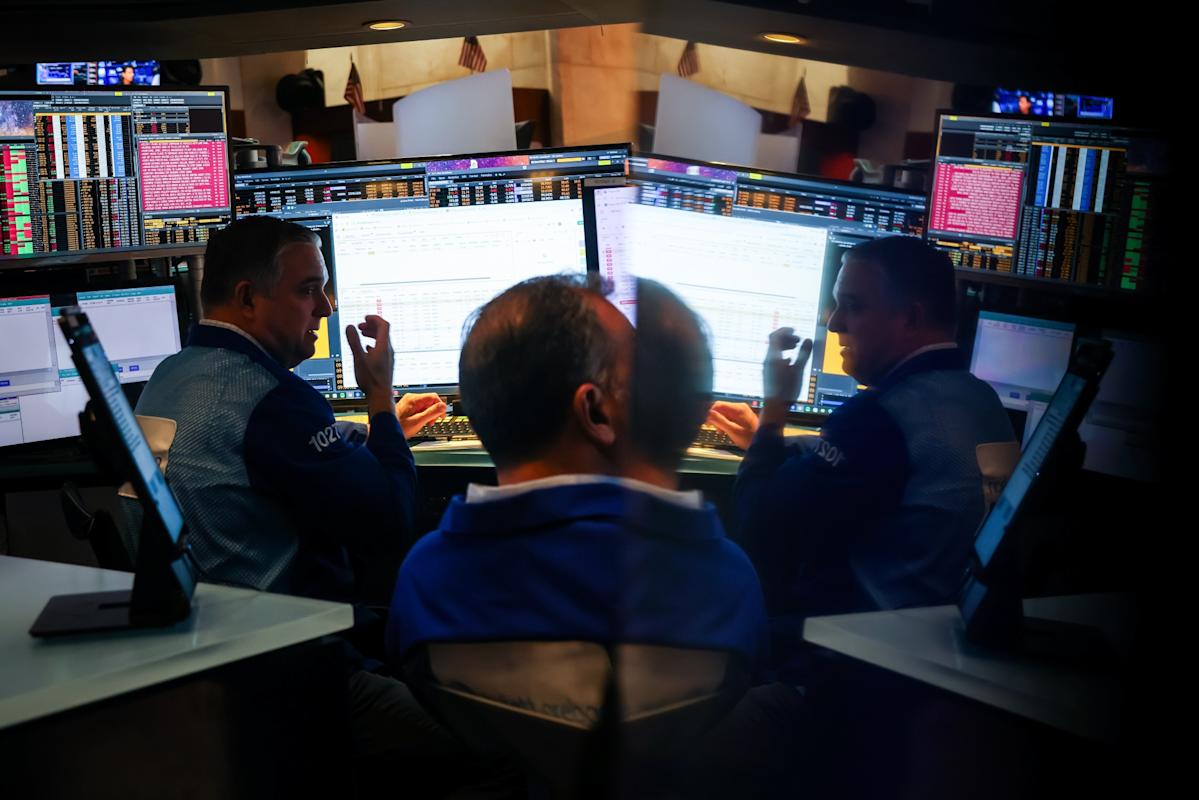Traders Brush Off Inflation Risk as They Bet on Smooth Rate Path
Traders work on the floor at the New York Stock Exchange (NYSE) in New York.
(Bloomberg) — Now that a September rate cut is all but sealed, options pros are expecting smooth sailing in the stock market through Thursday’s consumer price index reading. But that could turn out to be a dangerous bet if it shows inflation starting to run hot.
Most Read from Bloomberg
The logic behind the expectations for a rate cut at the Federal Reserve’s Sept. 16-17 policy meeting is pretty simple. Job growth is stagnating in the US, so the economy could use a jolt. That was reinforced on Friday, when disappointing August employment figures and the highest unemployment rate since 2021 led investors to fully price in a quarter-point reduction from the Fed next week.
The market digested the news with a shrug, as stocks sold off mildly on Friday and the Cboe Volatility Index, or VIX, crept higher but stayed well below the key 20 level, where it’s mostly been since June. Looking ahead, options traders are betting the S&P 500 Index will post a modest swing on Thursday following the CPI report, with a projected move of nearly 0.7% in either direction, according to data compiled by Piper Sandler & Co. That’s well below an average realized move of 1% over the past year.
The trade, while entirely logical based on the current view of the stock market, misses one major risk: What if there’s a big inflation surprise in these numbers?
“It’s a very tight balancing act right now,” said Eric Teal, chief investment officer at Comerica Wealth Management. “Anything really positive or really negative can change the outlook.”
The threat of a string of hot inflation prints is real due to President Donald Trump’s trade wars, aggressive deportations and cuts to the government workforce. And that could prevent the Fed from reducing rates as much as traders hope this year.
“The path for cuts might become a little shallower and lead to volatility in markets,” said Sameer Samana, head of global equities and real assets at Wells Fargo Investment Institute Inc.
Data Turbulence
While it looks like volatility has vanished, traders are still obsessed with macroeconomic data, creating lots of turbulence around economic releases. Over the past three months, the S&P 500’s average volatility on days when CPI, monthly jobs figures and Fed rate decisions are released has been nearly 50% higher than in all other sessions, according to data complied by Asym 500.
Story Continues
Source: Asym 500Source: Asym 500
The market is currently full of “macro tourists, people who are short-term traders in and out of markets trying to trade macro releases like the jobs report or the CPI,” said Brian Madden, chief investment officer at First Avenue Investment Counsel.
With traders fully pricing in a cut in September — and a total of 142 basis points of easing over the next 12 months — any signs of persistent inflation may fuel big stock swings if investors are forced to reign in dovish bets.
Indeed, Wall Street pros are preparing for another hot inflation print. The forecast for the August core CPI reading, which excludes food and energy costs, is a 0.3% rise from a month earlier. That would leave it up 3.1% year-over-year — well above the Fed’s 2% target and matching the readings from the prior month.
“You are seeing that the macro matters more and more, and if you’re a long-term investor, you want the macro economic data to matter,” said Sadiq Adatia, chief investment officer at BMO Global Asset Management Inc., which manages C$226 billion ($163 billion). “What you don’t want is noise.”
For much of the year, stocks have moved on tariff headlines and other “noise,” Adatia said.
Market Divergence
But an interesting thing is happening in financial world since the S&P 500 jumped more than 10% between Memorial Day and Labor Day for its third-best summer in nearly 40 years, according to Raymond James data. There’s suddenly a growing divergence in volatility in the stock and bond markets.
The VIX, which measures expected price swings in the S&P 500, is sitting steps away from the lowest level this year. Meanwhile, the ICE BofA MOVE Index, the bond market’s version of the VIX, gained 10 points on Tuesday and Wednesday combined in its biggest two-day advance since the height of the tariff turmoil in April. That signaled the bond market is bracing for volatility to pick up soon.
As a result, the ratio between the two is hovering near the lowest level since February.
All of which means traders are staring anxiously at fixed-income markets for an early read on when volatility in the S&P 500 could start to spike again.
“It’s not surprising that markets are reacting more to economic data releases during this period of heightened policy uncertainty,” said Mandy Xu, head of derivatives market intelligence at Cboe Global Markets. “While a rate cut at the upcoming September meeting is almost a foregone conclusion at this point, new data releases could change expectations of how fast and deep the Fed will cut in the coming months.”
————-Businessweek
©2025 Bloomberg L.P.








